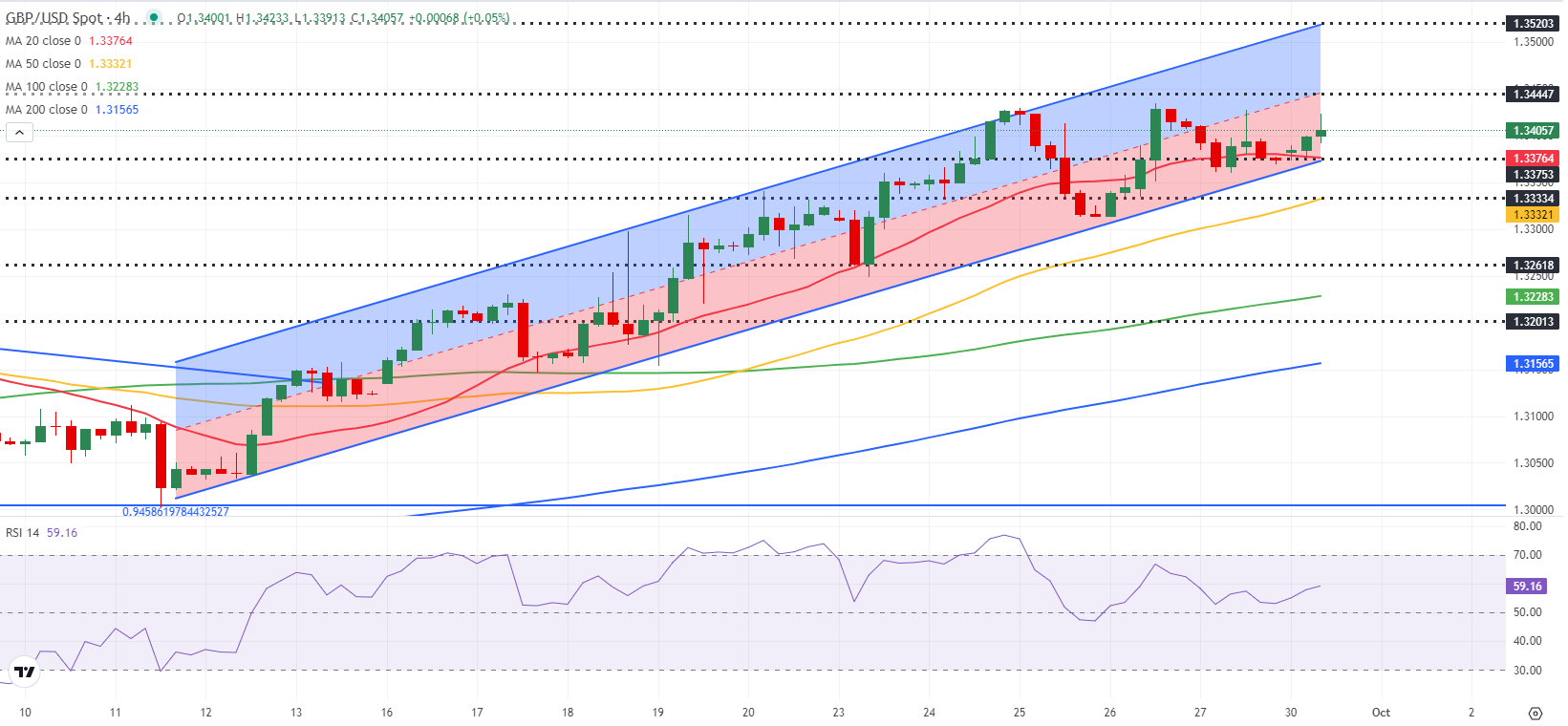- GBP/USD trades comfortably above 1.3400 in the European session on Monday.
- The technical picture suggests that the bullish bias remains intact.
- Markets await Fed Chairman Powell's speech on the economic outlook.
GBP/USD registered small losses on Friday but managed to end the second consecutive week in positive territory. The pair holds its ground early Monday and trades above 1.3400.
British Pound PRICE Last 7 days
The table below shows the percentage change of British Pound (GBP) against listed major currencies last 7 days. British Pound was the strongest against the US Dollar.
| USD | EUR | GBP | JPY | CAD | AUD | NZD | CHF | |
|---|---|---|---|---|---|---|---|---|
| USD | -0.30% | -0.63% | -0.98% | -0.34% | -1.73% | -1.94% | -0.82% | |
| EUR | 0.30% | -0.38% | -0.65% | 0.00% | -1.49% | -1.64% | -0.53% | |
| GBP | 0.63% | 0.38% | -0.21% | 0.38% | -1.11% | -1.27% | -0.14% | |
| JPY | 0.98% | 0.65% | 0.21% | 0.66% | -0.84% | -0.97% | 0.05% | |
| CAD | 0.34% | -0.01% | -0.38% | -0.66% | -1.34% | -1.62% | -0.50% | |
| AUD | 1.73% | 1.49% | 1.11% | 0.84% | 1.34% | -0.14% | 0.98% | |
| NZD | 1.94% | 1.64% | 1.27% | 0.97% | 1.62% | 0.14% | 1.14% | |
| CHF | 0.82% | 0.53% | 0.14% | -0.05% | 0.50% | -0.98% | -1.14% |
The heat map shows percentage changes of major currencies against each other. The base currency is picked from the left column, while the quote currency is picked from the top row. For example, if you pick the British Pound from the left column and move along the horizontal line to the US Dollar, the percentage change displayed in the box will represent GBP (base)/USD (quote).
The selling pressure surrounding the US Dollar (USD) at the beginning of the new week helps GBP/USD stretch higher. The data published by the US Bureau of Economic Analysis showed on Friday that the core Personal Consumption Expenditures (PCE) Price Index rose 0.1% on a monthly basis in August, at a softer pace than the market expectation of 0.2%.
Meanwhile, the UK's Office for National Statistics announced earlier in the day that it revised down the annualized Gross Domestic Product (GDP) growth for the second quarter to 0.7% from the 0.9% reported in the advanced estimate. This data, however, failed to trigger a noticeable market reaction.
Later in the American session, Federal Reserve (Fed) Chairman Jerome Powell will speak on the economic outlook at the National Association for Business Economics Annual Meeting, starting at 17:00 GMT. Fed Governor Michelle Bowman is also scheduled to deliver a speech in the early American session.
The CME FedWatch Tool shows that markets are seeing a nearly 50% probability of the Fed lowering the policy rate by 25 basis points (bps) at the next policy meeting in early November. The market positioning suggests that the US Dollar (USD) faces a two-way risk. In case Powell leaves the door open for another large rate cut, the USD could continue to weaken against its major rivals. On the other hand, GBP/USD could lose its traction if he signals that they will adopt a gradual approach to further policy easing.
GBP/USD Technical Analysis
GBP/USD remains within the ascending regression channel coming from September 12 and the Relative Strength Index (RSI) indicator on the 4-hour chart stays near 60, reflecting the bullish bias.
On the upside, 1.3440 (mid-point of the ascending channel) aligns as next resistance before 1.3500 (round level) and 1.3520 (upper limit of the ascending channel). Looking south, supports could be spotted at 1.3375 (lower limit of the ascending channel), 1.3330 (50-period Simple Moving Average) and 1.3300 (round level).
Fed FAQs
Monetary policy in the US is shaped by the Federal Reserve (Fed). The Fed has two mandates: to achieve price stability and foster full employment. Its primary tool to achieve these goals is by adjusting interest rates. When prices are rising too quickly and inflation is above the Fed’s 2% target, it raises interest rates, increasing borrowing costs throughout the economy. This results in a stronger US Dollar (USD) as it makes the US a more attractive place for international investors to park their money. When inflation falls below 2% or the Unemployment Rate is too high, the Fed may lower interest rates to encourage borrowing, which weighs on the Greenback.
The Federal Reserve (Fed) holds eight policy meetings a year, where the Federal Open Market Committee (FOMC) assesses economic conditions and makes monetary policy decisions. The FOMC is attended by twelve Fed officials – the seven members of the Board of Governors, the president of the Federal Reserve Bank of New York, and four of the remaining eleven regional Reserve Bank presidents, who serve one-year terms on a rotating basis.
In extreme situations, the Federal Reserve may resort to a policy named Quantitative Easing (QE). QE is the process by which the Fed substantially increases the flow of credit in a stuck financial system. It is a non-standard policy measure used during crises or when inflation is extremely low. It was the Fed’s weapon of choice during the Great Financial Crisis in 2008. It involves the Fed printing more Dollars and using them to buy high grade bonds from financial institutions. QE usually weakens the US Dollar.
Quantitative tightening (QT) is the reverse process of QE, whereby the Federal Reserve stops buying bonds from financial institutions and does not reinvest the principal from the bonds it holds maturing, to purchase new bonds. It is usually positive for the value of the US Dollar.
Information on these pages contains forward-looking statements that involve risks and uncertainties. Markets and instruments profiled on this page are for informational purposes only and should not in any way come across as a recommendation to buy or sell in these assets. You should do your own thorough research before making any investment decisions. FXStreet does not in any way guarantee that this information is free from mistakes, errors, or material misstatements. It also does not guarantee that this information is of a timely nature. Investing in Open Markets involves a great deal of risk, including the loss of all or a portion of your investment, as well as emotional distress. All risks, losses and costs associated with investing, including total loss of principal, are your responsibility. The views and opinions expressed in this article are those of the authors and do not necessarily reflect the official policy or position of FXStreet nor its advertisers. The author will not be held responsible for information that is found at the end of links posted on this page.
If not otherwise explicitly mentioned in the body of the article, at the time of writing, the author has no position in any stock mentioned in this article and no business relationship with any company mentioned. The author has not received compensation for writing this article, other than from FXStreet.
FXStreet and the author do not provide personalized recommendations. The author makes no representations as to the accuracy, completeness, or suitability of this information. FXStreet and the author will not be liable for any errors, omissions or any losses, injuries or damages arising from this information and its display or use. Errors and omissions excepted.
The author and FXStreet are not registered investment advisors and nothing in this article is intended to be investment advice.
Recommended Content
Editors’ Picks

AUD/USD: Further recovery targets 0.6400
AUD/USD soared to three-day highs around 0.6180 on Wednesday, bouncing back from multi-year lows near 0.5900 as easing worries over US tariffs helped fuel the recovery.

EUR/USD misses the boat on market-wide tariff relief rally
EUR/USD remains bogged down on the carts, caught in the much between 1.1000 and 1.0900 despite a broad-market recovery in investor risk appetite after the US once again pivoted away from its own tariff policies.

Gold drifts higher above $3,050 amid escalating US-China trade tensions
Gold price edges higher to around $3,080 during the early Asian session on Wednesday. The safe-haven demand amid escalating trade tensions between the United States and China provides some support to the precious metal.

Senate approves Paul Atkins as new SEC Chair
The Senate voted 52-44 on Wednesday to approve Paul Atkins as the new SEC Chair. The news could improve sentiment in the crypto market, considering Atkins has previously advocated for better crypto regulations and served as an advisor to crypto companies.

Tariff rollercoaster continues as China slapped with 104% levies
The reaction in currencies has not been as predictable. The clear winners so far remain the safe-haven Japanese yen and Swiss franc, no surprises there, while the euro has also emerged as a quasi-safe-haven given its high liquid status.

The Best brokers to trade EUR/USD
SPONSORED Discover the top brokers for trading EUR/USD in 2025. Our list features brokers with competitive spreads, fast execution, and powerful platforms. Whether you're a beginner or an expert, find the right partner to navigate the dynamic Forex market.
